

How to dye fabric, Natural dye fabric, Diy dye. Www.instructables. Anthotypes and cyanotypes are both ways of printing an image onto a piece of paper using light.
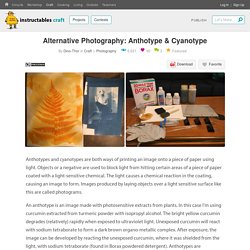
Objects or a negative are used to block light from hitting certain areas of a piece of paper coated with a light-sensitive chemical. The light causes a chemical reaction in the coating, causing an image to form. Images produced by laying objects over a light sensitive surface like this are called photograms. An anthotype is an image made with photosensitive extracts from plants. Pin on Print Festival. Kiezelzuur: oplosbaar glas. Rubia tinctorum. Pin on Ink Making. Pin on To dye another day. How to dye fabric, Natural dye fabric, Indigo plant. Lake pigment. Pigment made by precipitating a dye with an inert binder, or "mordant" Etymology[edit] The term "lake" is derived from the term lac, the secretions of the Indian wood insect Laccifer lacca (formerly known as the Coccus lacca).[3][4] It has the same root as the word lacquer, and comes originally from the Hindi word lakh, through the Arabic word lakk and the Persian word lak.[5] Chemistry[edit] Many lake pigments are azo dyes.

They characteristically have sulfonate and sometimes carboxylate substituents, which confer negative charge to the chromophore (colored species). The metallic salts or binders used are typically colourless or almost so.[1] The organic component of the dye determines the color of the resulting precipitate.
History and art[edit] Lake pigments have a long history in decoration and the arts. Indigo and rose madder are now produced more cheaply from synthetic sources, although some use of natural products persists, especially among artisans. References[edit] Precipitation (chemistry) Chemical process Sometimes the formation of a precipitate indicates the occurrence of a chemical reaction.

If silver nitrate solution is poured into a solution of sodium chloride, a chemical reaction occurs forming a white precipitate of silver chloride. When potassium iodide solution reacts with lead(II) nitrate solution, a yellow precipitate of lead(II) iodide is formed. Precipitation may occur if the concentration of a compound exceeds its solubility (such as when mixing solvents or changing their temperature). Precipitation may occur rapidly from a supersaturated solution. Copper from a wire is displaced by silver in a silver nitrate solution it is dipped into, and solid silver precipitates out.
Pinterest. Pinterest. Pinterest. Meekrap. Natural dye. Naturally dyed skeins made with madder root, Colonial Williamsburg, VA The discovery of man-made synthetic dyes in the mid-19th century triggered a long decline in the large-scale market for natural dyes.

Synthetic dyes, which could be produced in large quantities, quickly superseded natural dyes for the commercial textile production enabled by the industrial revolution, and unlike natural dyes, were suitable for the synthetic fibres that followed. Artists of the Arts and Crafts Movement preferred the pure shades and subtle variability of natural dyes, which mellow with age but preserve their true colors, unlike early synthetic dyes,[1] and helped ensure that the old European techniques for dyeing and printing with natural dyestuffs were preserved for use by home and craft dyers. Natural dyeing techniques are also preserved by artisans in traditional cultures around the world. Dyes in use in the fashion industry[edit] A book on vegetable dyes : Mairet, Ethel M : Free Download, Borrow, and Streaming. Natural Dyes - Osage Orange – Folk Fibers. Osage Orange is one of my favorite dye sources for creating a range of golden yellows, metallic and russet golds, as well as soft mossy greens.
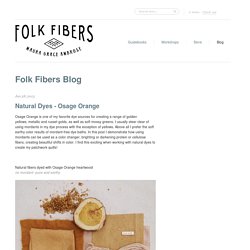
I usually steer clear of using mordants in my dye process with the exception of yellows. Above all I prefer the soft earthy color results of mordant-free dye baths. Making Ink From Berries: By Dana Driscoll – The Fruit Nut. Making Ink from Berries (Pokeberry, Huckleberry, etc.)

Element. Once you start making ink, the world never quite looks the same.
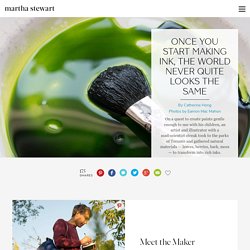
Just ask Jason Logan, founder of the Toronto Ink Company, who's reviving the lost art of creating natural inks. "You can make them out of almost anything," he says — often using the most mundane of materials, which he forages from right outside his doorstep in Toronto. Element. Make Ink & Paper at Home for Kids. Deze spijkerbroek is geverfd met olijfbladeren en amandelen. New Experiments. My life has undergone quite a sea change since I last wrote.
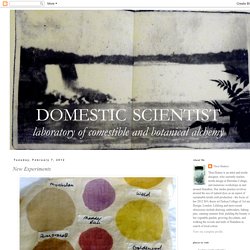
First, I left reasonably stable employment as a studio technician and teacher to go back to school. Second, and slightly more dramatically, after a mad summer of dyeing, knitting, canning, pickling, gardening, farming and craft-fairing, I left my friends, family and ninety-nine percent of my possessions behind and moved to London, England, to begin a master's degree in textiles at Chelsea College of Art and Design. This venture had been contemplated for some long time, and pondered with my typical amount of vacillation, hesitation and constant what-ifs.
Now here, I sometimes question how this could be my life - living in London - but I consider myself very fortunate to be given the opportunity to devote this kind of focused time to my studio practice. - Textiel verven met plantaardige verfstoffen. Verfplanten Vóór de komst van de synthetische kleurstoffen (ca. 1850) werd textiel gekleurd met kleurstoffen die uit planten werden bereid.

Heel wat planten lenen zich tot het bereiden van kleurstof, maar de voornaamste waren wel de Meekrap voor rood, de Wede en de Indigostruik voor blauw en Saffloer en Geelwortel (Curcuma) voor geel. How to make Oak Gall Ink. Many of the recipes we viewed suggested adding Gum Arabic to the Ink to improve its ability to hold itself in suspension.
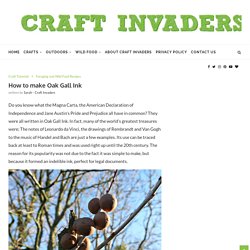
We did add half a teaspoon in powdered form to the tannin solution before straining it through a filter paper, but I’m not convinced that we managed to get much of it to dissolve. We popped our tannin-rich solution into a bowl and started adding the iron solution. The chemical reaction was immediate. As soon as the iron hit the tannin, the liquid turned black. How to make green — Botanical Threads.
Each month, without fail I get asked which plants can be used to make a green dye. Surprisingly, a true green is actually quite hard to create from plants and more often than not the ‘green’ will be more of a yellow, grey or brown shade rather than the sort of rich lime or emerald colours that people are trying to create. Luckily for you, I’ve discovered a few plants that do actually make really lovely shades of green and I’ll share them with you below.
Chlorophyll Extract. How to Make Dye from Acorns - FiberArtsy.com. Learn how to make a Natural Dye made from Acorns for Cotton Fabric In the past year or so, I shared my natural dyeing experiments with black walnuts, dandelions and black beans. Continuing this series, I wanted to show you how to dye cotton fabric towels using Acorns. Last Fall, my hubby and I spent our anniversary weekend camping and hiking at a beautiful state park in Indiana. While tackling a 7 mile hike one day, I found myself in the middle of a bunch of huge oak trees. They must have just dropped their acorns because the ground was literally covered. 30 Amazing Plants From Your Garden To Use As Dye - Gardening Know How's Blog. Extracting Woad: a natural blue pigment for dyeing and soap making. Planting your Natural Dye Garden for a Full Palette of Natural Colors. From Your Kitchen to Your Studio: At Home Botanical Dyes.
Our first natural dye tutorial focused on extracting cochineal dye purchased from a supplier. Whether you’re new to naturally dyeing handmade paper or looking to expand your color range, potential dyestuff might live closer than you think—you can extract dyes from items found in your kitchen. Keep reading to learn about more ways to experiment with natural dyes and handmade paper!
The Leaf Guide: 25 Plants for Eco-printing on Cotton – Gumnut Magic. This ebook covers 25 plants which eco-print well on cotton. There is information about identifying and preparing each plant, with photographs of the leaves themselves and the types of prints they produce. MPS (Méthodes et pratiques scientifiques) An Introduction to Natural Dyeing Choosing Your Plants Begin by looking at what you already have in your own backyard or outdoor space. Any plant you have a lot of will most likely produce some color in the dyepot. Generally, the more plant material you have, the more you can add to the pot, and the more concentrated your dye will be. Making Natural Dyes from Plants. Did you know that a great source for natural dyes can be found right in your own back yard! Roots, nuts and flowers are just a few common natural ways to get many colors.
Yellow, orange, blue, red, green, brown and grey are available. Go ahead, experiment! Gathering plant material for dyeing: Blossoms should be in full bloom, berries ripe and nuts mature. Remember, never gather more than 2/3 of a stand of anything in the wild when gathering plant stuff for dying. To make the dye solution: Chop plant material into small pieces and place in a pot. Getting the fabric ready for the dye bath: You will have to soak the fabric in a color fixative before the dye process. Color Fixatives: Salt Fixative (for berry dyes) 1/2 cup salt to 8 cups cold water Plant Fixatives (for plant dyes) 4 parts cold water to 1 part vinegar Add fabric to the fixative and simmer for an hour. Dye Bath: Place wet fabric in dye bath. From crushed bugs to cow urine: the history of colours – in pictures. Scarf Dyeing with Natural Plant Materials – mulberrypatchquilts.